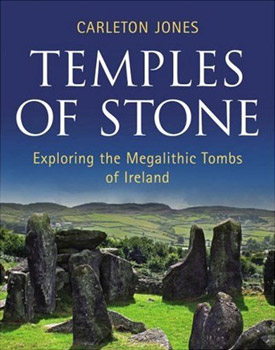
Temples of Stone
Temples of Stone - Exploring the Megalithic Tombs of Ireland by Carleton Jones.Excellent reference book on the significant Megalithic sites of Ireland. Carleton Jones has distilled the knowledge of all the relevant previous publications and combined it with his own research and photographs to create a must have book for anyone interesting in the Megalithic Tombs of Ireland.
Dr. Carleton Jones lectures in Archaeology at the National University of Ireland in Galway. The book is aimed at the general reader, it is attractively laid out with many excellent photographs.
Purchase at Amazon.com or Amazon.co.uk
After 4000 years of silence, however, the stones are no longer mute. Every year, archaeologists discover more about these enigmatic monuments and instead of a single, simple answer to the question of what the megalithic tombs meant to those who built them, there is a multitude of answers, each one more intriguing that the next.
As the Office of Public Works celebrates 40 years of the winter solstice at Newgrange, Carleton Jones brings together the interpretations surrounding our megalithic tombs in a fully illustrated popular format, shedding light on our ancestors belief systems and rituals and their deliberate manipulations of the world around them, often with drug induced hallucinations. All key sites in Ireland are discussed with 100 Sites Worth Visiting listed in a final chapter with photos, maps and detailed directions.
Dr Carleton Jones lectures in archaeology at the National University of Ireland, Galway. Author of The Burren and the Aran Islands Exploring the Archaeology, his work is widely published.
Preface
Around 6,000 years ago, the members of a now long-forgotten tribe gathered together and changed Ireland forever. They had an idea, a concept of something that did not yet exist, but something that they were determined to create. They dragged and lifted carefully chosen stones into place and through their exertions, they made their idea a reality. What those people accomplished in that very distant time still resonates down the ages to us today, because what they built was Ireland's first megalithic tomb – the first temple of stone ever built on the island.We are not certain which megalithic tomb in Ireland was that first monument or even if it still exists today, but we do know that in the centuries that followed, over 1,600 more megalithic tombs were built throughout Ireland. Then around 2,000 years after the first megalithic tomb was constructed, this great building project stopped, and the knowledge of what these remarkable structures meant to their builders was lost.
After 4,000 years of silence, however, the stones are no longer mute. Every year archaeologists are discovering more and more about these enigmatic monuments and instead of a single, simple answer to the question of what the megalithic tombs meant to those who built them, there is a multitude of answers, each one more fascinating than the next.
At one level, the megalithic tombs were powerful symbolic tools, tools that allowed people to think in new ways and to break away from the traditional narratives that had governed their ancestors. At another level, megalithic tombs served to transform both space and time by creating permanent structures that endured against the fleeting generations.
Beliefs and ideas about life and death also seem to have been woven into the fabric of the megalithic tombs and it is likely that local groups used megalithic tombs to interact with their ancestors. We also have evidence that sound and colour played a role in their megalithic rituals, and we even have evidence that some of the ritual participants were probably hallucinating, perhaps as a way of journeying to an Otherworld where their ancestors and other spirits resided.
Other lines of enquiry have shown how some megalithic tombs were closely linked to the natural world and how whole landscapes were ritualised through the construction of interconnected networks of monuments, sometimes over 50km apart.
All these lines of evidence and more are now bringing the world of the megaliths back to life. We can now see that it was a tribal world where Stone Age farmers defended their territory against neighbouring tribes and where fertility and regeneration were constant concerns. It was also a world full of spirits, gods and goddesses and a world where shamans interceded with the dead. Although it was a world of deep traditions, it was also a world in which people strove to further understand the mysteries of life and death, as well as humanity's place in the cosmos.
As such, we can see that it was a world where people had thoughts and concerns far beyond day-to-day survival. Today, we stand and marvel at these ancient sites and this is as it should be because these unlikely masses of stone – heaved, levered and shoved into place – these temples of stone are testaments to our ancestor's quest for knowledge and to their ability to change the world.
Dolmens and burial chambers dot the Irish countryside and fascinate all. Once dismissed as 'rude monuments' shrouded in mystery, fresh archaeological interpretations provide new ways of understanding these ancient structures. Who were the megalith builders? Why did they heave these massive stones on top of one another? What can these evocative monuments tell us about how their builders understood the world and their place in it? How did the monuments alter ancient people's experience of place and time? What rituals took place in and around these monuments? Were drugs and hallucinations part of the rituals engaged in? How were the giant megaliths erected? And finally, why did people stop building them? Insights and answers to these questions are presented in a fully-illustrated popular format. All key sites in Ireland are discussed. 100 'Sites Worth Visiting' are listed in a final chapter with photos, maps, and detailed directions for visiting each site.
Boyne Valley Private Day Tour
 Immerse yourself in the rich heritage and culture of the Boyne Valley with our full-day private tours.
Visit Newgrange World Heritage site, explore the Hill of Slane, where Saint Patrick famously lit the Paschal fire.
Discover the Hill of Tara, the ancient seat of power for the High Kings of Ireland.
Book Now
Immerse yourself in the rich heritage and culture of the Boyne Valley with our full-day private tours.
Visit Newgrange World Heritage site, explore the Hill of Slane, where Saint Patrick famously lit the Paschal fire.
Discover the Hill of Tara, the ancient seat of power for the High Kings of Ireland.
Book Now
Home
| Newgrange
| Knowth
| Dowth
| Hill of Tara
| Fourknocks
| Loughcrew
| More Places
| Labyrinths
| Local Info
| Art Works
| Articles
| Images
| Books
| Links
| Boyne Valley Tours
| Contact
